Geopolymers Reinforced with Natural Fibers: A Comparison among Different Sources
Abstract
:Featured Application
Abstract
1. Introduction
2. Materials and Methods
2.1. Materials
2.1.1. Binder
2.1.2. Activators
2.1.3. Fibers
2.2. Composites Preparation
2.3. Characterization Tests
2.3.1. Water Absorption
2.3.2. Mechanical Tests
2.3.3. Water Permeability
2.3.4. Dimensional Stability
2.3.5. Microstructure
3. Results and Discussion
4. Conclusions
Author Contributions
Funding
Institutional Review Board Statement
Informed Consent Statement
Acknowledgments
Conflicts of Interest
References
- Korniejenko, K.; Łach, M.; Mikuła, J. The influence of short coir, glass and carbon fibers on the properties of composites with geopolymer matrix. Materials 2021, 14, 4599. [Google Scholar] [CrossRef]
- Rashad, A.M. The effect of polypropylene, polyvinyl-alcohol, carbon and glass fibres on geopolymers properties. Mater. Sci. Technol. 2019, 35, 127–146. [Google Scholar] [CrossRef]
- Shaikh, F.U.A. Review of mechanical properties of short fibre reinforced geopolymer composites. Constr. Build. Mater. 2013, 43, 37–49. [Google Scholar] [CrossRef] [Green Version]
- Ranjbar, N.; Zhang, M. Fiber-reinforced geopolymer composites: A review. Cem. Concr. Comp. 2020, 107, 103498. [Google Scholar] [CrossRef]
- Shanthini, D.; Grija, S.; Abinaya, S.; Devaki, R. Fibre reinforced geopolymer concrete—A review. Int. J. Civ. Eng. Technol. 2016, 7, 435–438. [Google Scholar]
- Saccani, A.; Manzi, S.; Lancellotti, I.; Lipparini, L. Composites obtained by recycling carbon fibre/epoxy composite wastes in building materials. Constr. Build. Mater. 2019, 204, 296–302. [Google Scholar] [CrossRef]
- Manzi, S.; Lancellotti, I.; Masi, G.; Saccani, A. Alkali-activated binders from waste incinerator bottom ashes and metakaolin reinforced by recycled carbon fiber composites. Front. Mater. 2020, 7, 583400. [Google Scholar] [CrossRef]
- Yan, L.; Kasal, B.; Huang, L. A review of recent research on the use of cellulosic fibres, their fibre fabric reinforced cementitious, geopolymer and polymer composites in civil engineering. Compos. Part. B Eng. 2016, 92, 94–132. [Google Scholar] [CrossRef]
- Silva, G.; Kim, S.; Aguilar, R.; Nakamatsu, J. Natural fibers as reinforcement additives for geopolymers—A review of potential eco-friendly applications to the construction industry. Sustain. Mater. Technol. 2020, 23, e00132. [Google Scholar] [CrossRef]
- Camargo, M.M.; Taye, E.A.; Roether, J.A.; Redda, D.T.; Boccaccini, A.R. A review on natural fiber-reinforced geopolymer and cement-based composites. Materials 2020, 13, 4603. [Google Scholar] [CrossRef]
- Korniejenko, K.; Łach, M.; Dogan-Saglamtimur, N.; Furtos, G.; Mikuła, J. The overview of mechanical properties of short natural fiber reinforced geopolymer composites. Environ. Res. Technol. 2020, 3, 28–39. [Google Scholar] [CrossRef]
- Alzeer, M.; MacKenzie, K. Synthesis and mechanical properties of novel composites of inorganic polymers (geopolymers) with unidirectional natural flax fibres (phormium tenax). Appl. Clay Sci. 2013, 75, 148–152. [Google Scholar] [CrossRef]
- Lazorenko, G.; Kasprzhitskii, A.; Yavna, V.; Mischinenko, V.; Kukharskii, A.; Kruglikov, A.; Kolodina, A.; Yalovega, G. Effect of pre-treatment of flax tows on mechanical properties and microstructure of natural fiber reinforced geopolymer composites. Environ. Technol. Innov. 2020, 20, 101105. [Google Scholar] [CrossRef]
- Assaedi, H.; Shaikh, F.U.A.; Low, I.M. Influence of mixing methods of nano silica on the microstructural and mechanical properties of flax fabric reinforced geopolymer composites. Constr. Build. Mater. 2016, 123, 541–552. [Google Scholar] [CrossRef]
- Assaedi, H.; Alomayri, T.; Shaikh, F.U.A.; It-Meng, L. Characterisation of mechanical and thermal properties in flax fabric reinforced geopolymer composites. J. Adv. Ceram. 2015, 4, 272–281. [Google Scholar] [CrossRef] [Green Version]
- Wang, X.; Yuan, Z.; Zhan, X.; Li, Y.; Li, M.; Shen, L.; Cheng, D.; Li, Y.; Xu, B. Multi-scale characterization of the thermal—Mechanically isolated bamboo fiber bundles and its potential application on engineered composites. Constr. Build. Mater. 2020, 262, 120866. [Google Scholar] [CrossRef]
- Sá Ribeiro, R.A.; Sá Ribeiro, M.G.; Sankar, K.; Kriven, W.M. Geopolymer-bamboo composite—A novel sustainable construction material. Constr. Build. Mater. 2016, 123, 501–507. [Google Scholar] [CrossRef]
- Sankar, K.; Sá Ribeiro, R.A.; Sá Ribeiro, M.G.; Kriven, W.M. Potassium-based geopolymer composites reinforced with chopped bamboo fibers. J. Am. Ceram. Soc. 2017, 100, 49–55. [Google Scholar] [CrossRef]
- Da Costa Correia, V.; Ardanuy, M.; Claramunt, J.; Savastano, H. Assessment of chemical and mechanical behavior of bamboo pulp and nanofibrillated cellulose exposed to alkaline environments. Cellulose 2019, 26, 9269–9285. [Google Scholar] [CrossRef]
- Zhou, B.; Wang, L.; Ma, G.; Zhao, X.; Zhao, X. Preparation and properties of bio-geopolymer composites with waste cotton stalk materials. J. Clean. Prod. 2020, 245, 118842. [Google Scholar] [CrossRef]
- Alomayri, T.; Shaikh, F.U.A.; Low, I.M. Synthesis and mechanical properties of cotton fabric reinforced geopolymer composites. Compos. Part. B Eng. 2014, 60, 36–42. [Google Scholar] [CrossRef] [Green Version]
- Galzerano, B.; Formisano, A.; Durante, M.; Iucolano, F.; Caputo, D.; Liguori, B. Hemp reinforcement in lightweight geopolymers. J. Comp. Mater. 2018, 52, 2313–2320. [Google Scholar] [CrossRef]
- Simonova, H.; Kucharczykov, B.; Topolar, L.; Kersner, Z.; Merta, I.; Dragas, J.; Ignjatovic, I.; Komljenovic, M.; Nikolic, V. Crack initiation of selected geopolymer mortars with hemp fibers. Procedia Struct. Integr. 2018, 13, 578–583. [Google Scholar] [CrossRef]
- Valášek, P.; Müller, M.; Šleger, V.; Kolaf, V.; Hromasova, M.; D’Amato, R.; Ruggiero, A. Influence of alkali treatment on the microstructure and mechanical properties of coir and abaca fibers. Materials 2021, 14, 2636. [Google Scholar] [CrossRef]
- Gierarda, W.; Rojewski, S.; Rozanska, W. Effectiveness of silanization and plasma treatment in the improvement of selected flax fibers’ properties. Materials 2021, 14, 3564. [Google Scholar] [CrossRef] [PubMed]
- Malinowski, R.; Raszkowska-Kaczor, A.; Moraczewski, K.; Głuszewski, W.; Krasinskyi, V.; Wedderburn, L. The structure and mechanical properties of hemp fibers-reinforced Poly(ε-Caprolactone) composites modified by electron beam irradiation. Appl. Sci. 2021, 11, 5317. [Google Scholar] [CrossRef]
- Asim, M.; Jawaid, M.; Abdan, K.; Ri. Ishak, M.R. Effect of alkali and silane treatments on mechanical and fibre-matrix bond strength of kenaf and pineapple leaf fibres. J. Bionic Eng. 2016, 13, 426–435. [Google Scholar] [CrossRef]
- Sanjay, M.R.; Siengchin, S.; Parameswaranpillai, J.; Jawai, M.; Pruncu, C.I.; Khan, A. A comprehensive review of techniques for natural fibers as reinforcement in composites: Preparation, processing and characterization. Carbohydr. Polym. 2019, 207, 108–121. [Google Scholar] [CrossRef]
- Azwa, Z.N.; Yousif, B.F. Characteristics of kenaf fibre/epoxy composites subjected to thermal degradation. Polym. Degrad. Stabil. 2013, 98, 2752. [Google Scholar] [CrossRef]
- Sisti, L.; Kalia, S.; Totaro, G.; Zanaroli, G.; Celli, A. Enzymatically treated curaua fibers in poly(butylene succinate)-based biocomposites. Environ. Eng. Chem. Eng. 2018, 6, 4452–4458. [Google Scholar] [CrossRef]
- Sisti, L.; Totaro, G.; Vannini, M.; Fabbri, P.; Zatta, A.; Celli, A. Evaluation of the retting process as a pre-treatment of vegetable fibers for the preparation of high-performance polymer biocomposites. Ind. Crop. Prod. 2016, 81, 56–65. [Google Scholar] [CrossRef]
- Dhakal, D.H.N.; Ismail, S.O. Sustainable Composites for Lightweight Applications; Woodhead Publishing by Elsevier: Amsterdam, The Netherlands, 2020; pp. 75–76. [Google Scholar] [CrossRef]
- Zakikhani, P.; Zahari, R.; Sultan, M.T.H.; Majid, D.L. Thermal degradation of four bamboo species. BioResources 2016, 11, 414–425. [Google Scholar] [CrossRef] [Green Version]
- Correja, E.A.; Torres, S.M.; Alexandre, M.; Gomes, K.C.; Barbosa, N.P.; Barros, S. Mechanical performance of natural fibers reinforced geopolymer composites. Mat. Sci. Forum 2013, 758, 139–145. [Google Scholar] [CrossRef]
- Mastali, M.; Abdollahhnejad, Z.; Pacheco Torgal, F. Carbon dioxide sequestration of fly ash alkaline based mortars containing recycled aggregates and reinforced by hemp fibres. Constr. Build. Mater. 2018, 160, 48–56. [Google Scholar] [CrossRef]
- Kim, D.J.; Naaman, A.E.; El-Tawil, S. Comparative flexural behaviour of four reinforced cementitious composites. Cem. Concr. Compos. 2008, 30, 917–928. [Google Scholar] [CrossRef]
- Da Fonseca, R.P.; Rocha, J.C.; Cheriaf, M. Mechanical properties of mortars reinforced with Amazon Rainforest natural fibers. Materials 2021, 14, 155. [Google Scholar] [CrossRef]



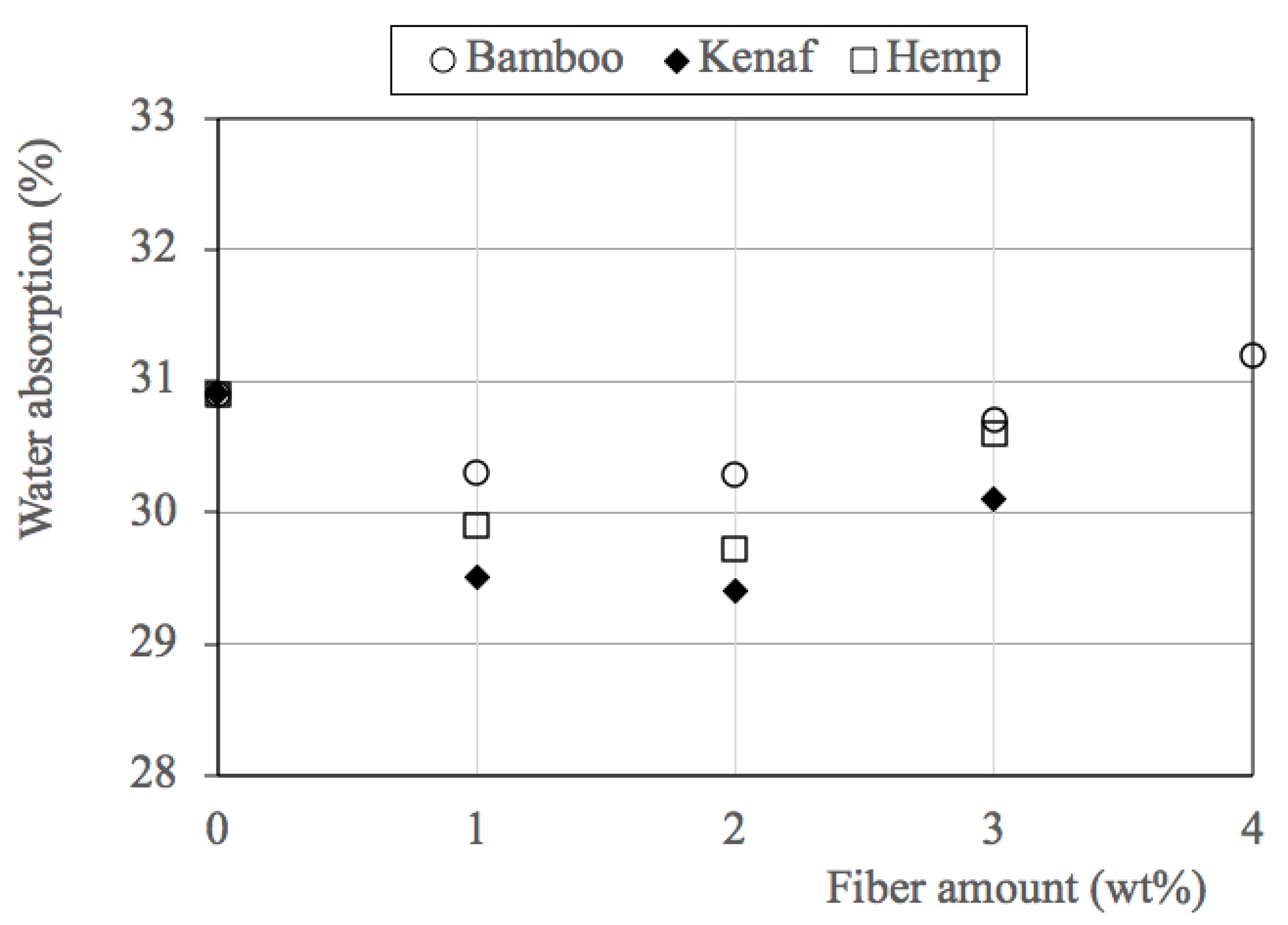
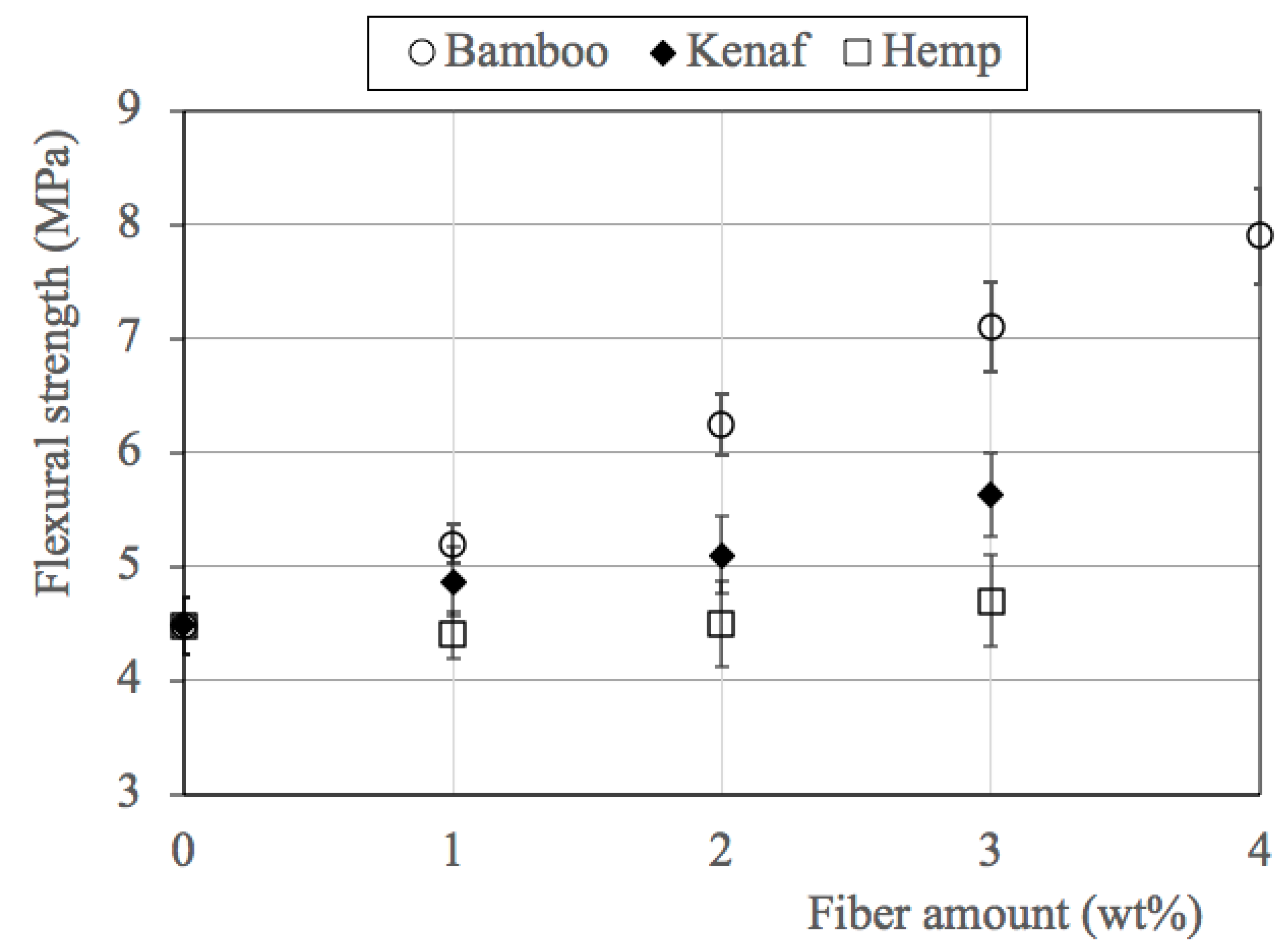
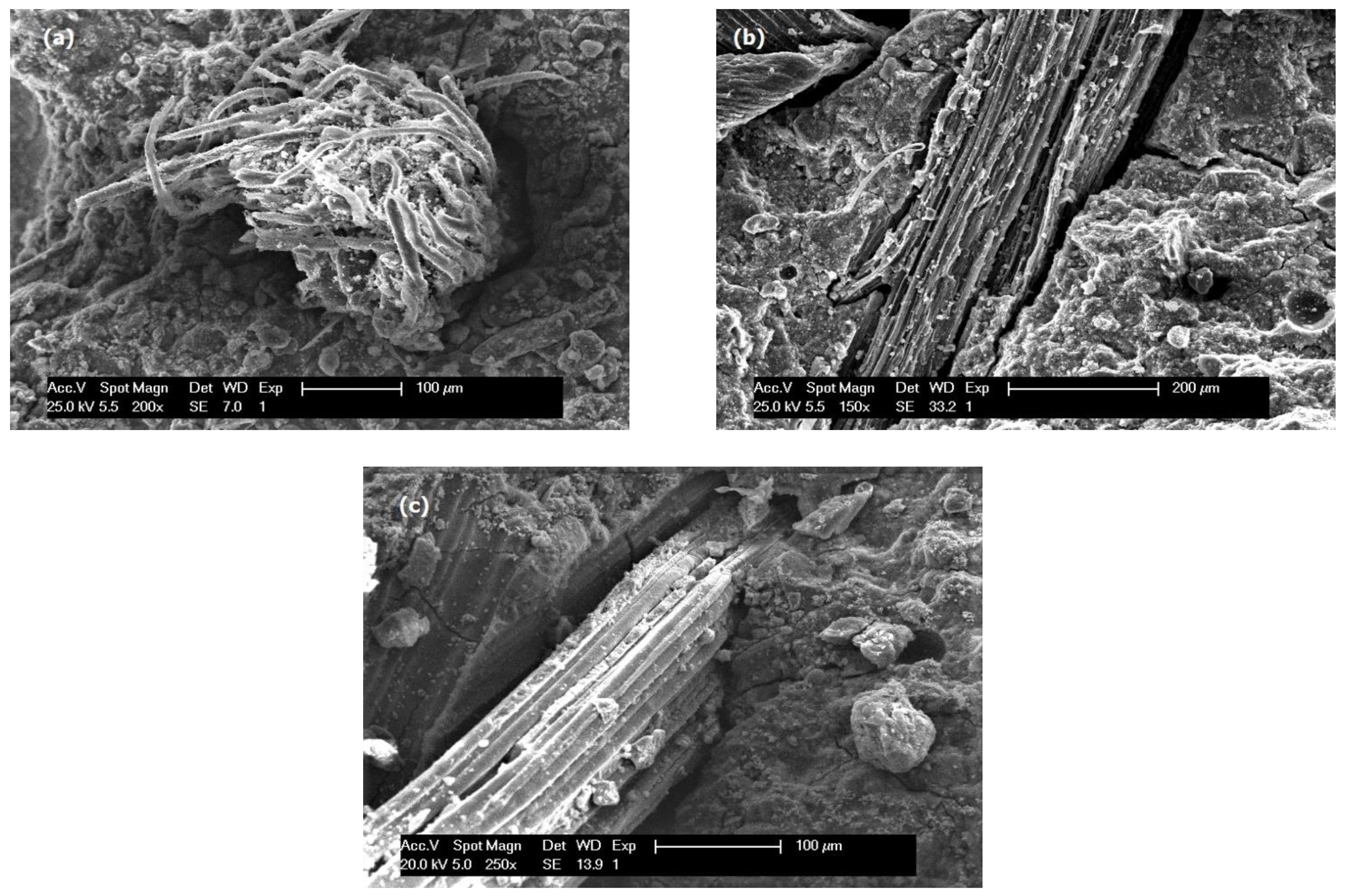

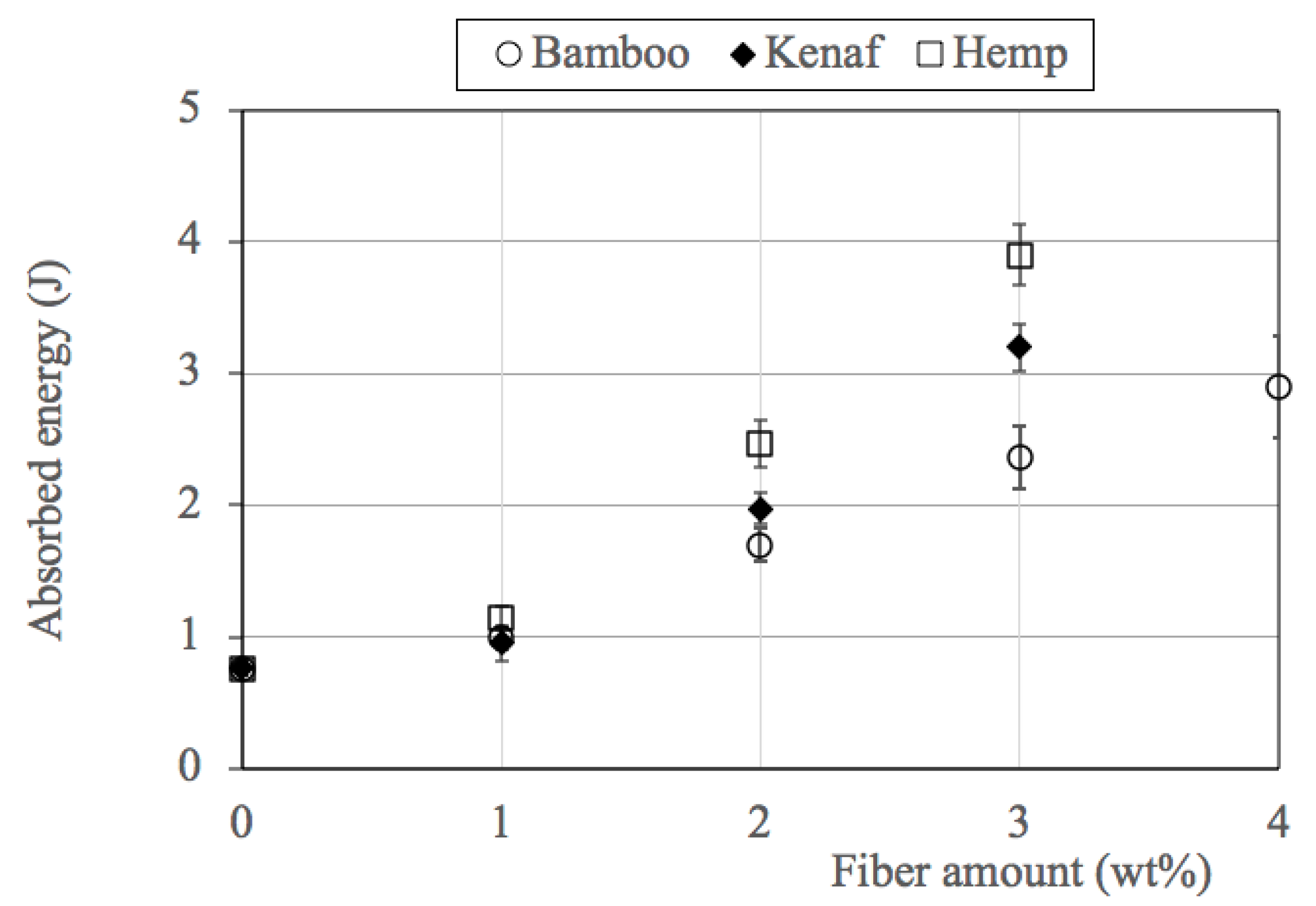
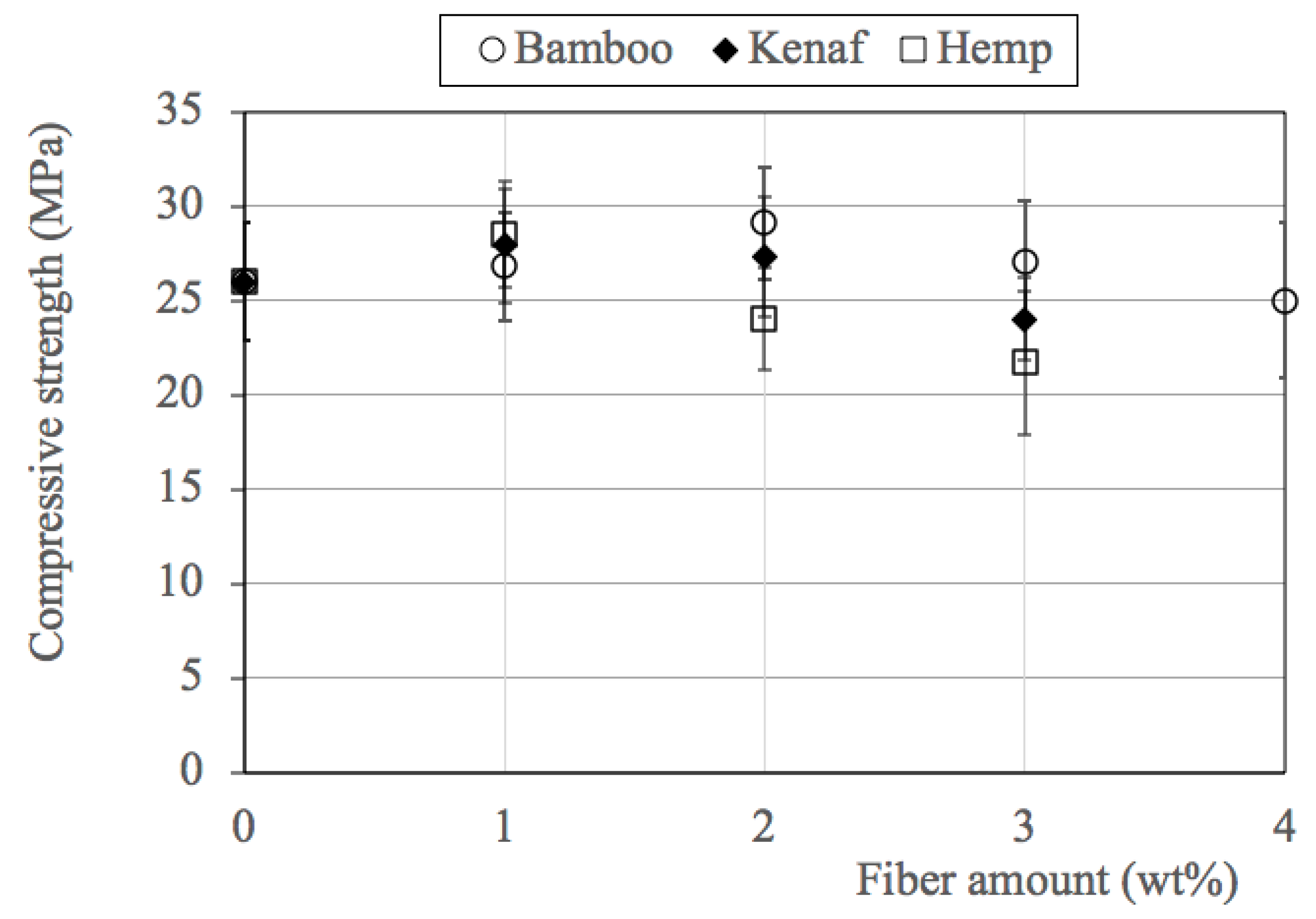

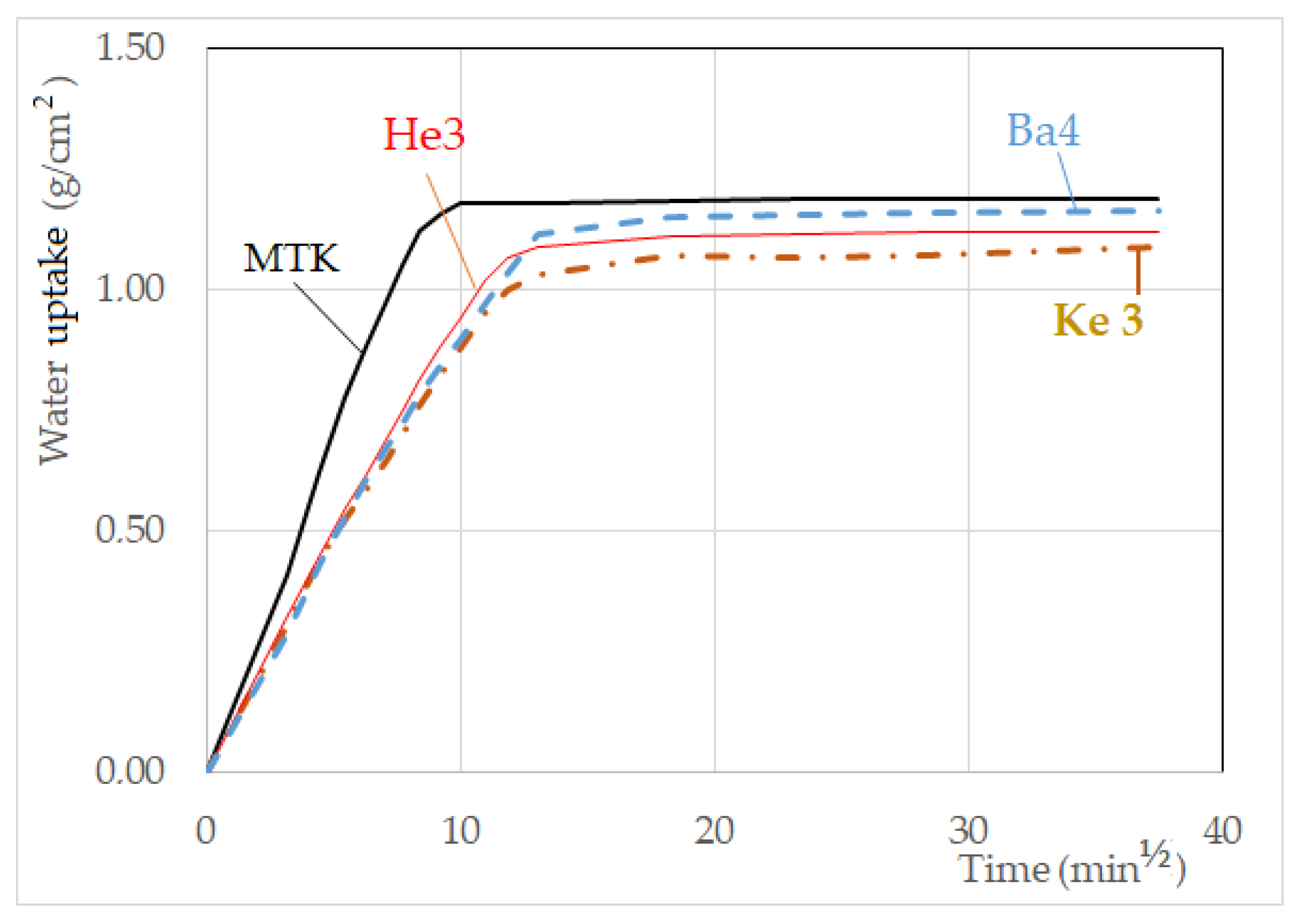
| Sample | Code | Metakaolin | Na2SiO3 + NaOH | Water | Fibers | wt% * |
|---|---|---|---|---|---|---|
| Metakaolin | MTK-0 | 100 | 15 + 15 | 5 | 0 | 0.00 |
| Metakaolin + 1%Kenaf | Ke1 | 100 | 15 + 15 | 5 | 1 | 0.73 |
| Metakaolin + 2%Kenaf | Ke2 | 100 | 15 + 15 | 5 | 2 | 1.46 |
| Metakaolin + 3%Kenaf | Ke3 | 100 | 15 + 15 | 5 | 3 | 2.17 |
| Metakaolin + 1%Hemp | He1 | 100 | 15 + 15 | 5 | 1 | 0.73 |
| Metakaolin + 2%Hemp | He2 | 100 | 15 + 15 | 5 | 2 | 1.46 |
| Metakaolin + 3%Hemp | He3 | 100 | 15 + 15 | 5 | 3 | 2.17 |
| Metakaolin + 1%Bamboo | Ba1 | 100 | 15 + 15 | 5 | 1 | 0.73 |
| Metakaolin + 2%Bamboo | Ba2 | 100 | 15 + 15 | 5 | 2 | 1.46 |
| Metakaolin + 3%Bamboo | Ba3 | 100 | 15 + 15 | 5 | 3 | 2.17 |
| Metakaolin + 4%Bamboo | Ba4 | 100 | 15 + 15 | 5 | 4 | 2.88 |
| Fibers | Tmax (°C) | Moisture (%) | Pectin and/or Hemicellulose(%) | Cellulose (%) | Lignin (%) | Residue (%) |
|---|---|---|---|---|---|---|
| Kenaf | 388 | ≈4 | ≈10 | ≈74 | / | 12 |
| Hemp | 363 | ≈3 | ≈12 | ≈48 | ≈14 | 23 |
| Bamboo | 339 | ≈3 | / | ≈60 | ≈10 | 26 |
Publisher’s Note: MDPI stays neutral with regard to jurisdictional claims in published maps and institutional affiliations. |
© 2021 by the authors. Licensee MDPI, Basel, Switzerland. This article is an open access article distributed under the terms and conditions of the Creative Commons Attribution (CC BY) license (https://creativecommons.org/licenses/by/4.0/).
Share and Cite
Saccani, A.; Molari, L.; Totaro, G.; Manzi, S. Geopolymers Reinforced with Natural Fibers: A Comparison among Different Sources. Appl. Sci. 2021, 11, 11026. https://doi.org/10.3390/app112211026
Saccani A, Molari L, Totaro G, Manzi S. Geopolymers Reinforced with Natural Fibers: A Comparison among Different Sources. Applied Sciences. 2021; 11(22):11026. https://doi.org/10.3390/app112211026
Chicago/Turabian StyleSaccani, Andrea, Luisa Molari, Grazia Totaro, and Stefania Manzi. 2021. "Geopolymers Reinforced with Natural Fibers: A Comparison among Different Sources" Applied Sciences 11, no. 22: 11026. https://doi.org/10.3390/app112211026






